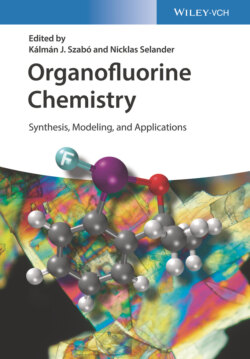Читать книгу Organofluorine Chemistry - Группа авторов - Страница 16
1.3.2 From Fluoroolefination to Fluoroalkylation
ОглавлениеAs mentioned in Section 1.3.1, 2‐PySO2CF2H was developed as a new gem‐difluoroolefination reagent and the sulfinate salt intermediate was found to be relatively stable and can be observed (see Scheme 1.11). Based on this fact, we realized a formal nucleophilic iodo‐ and bromodifluoromethylation of carbonyl compounds with 2‐PySO2CF2H via in situ halogenation of the sulfinate salt intermediates delivered from Smiles rearrangement (Scheme 1.14). By simply using “X+” reagents to quench the reaction instead of “H+,” we could, therefore, tune the pathway from fluoroolefination to fluoroalkylation.
Scheme 1.14 Halodifluoromethylation with 2‐PySO2CF2H.
Remarkably, a unique fluorine effect was observed in this reaction [29]. Unlike the reaction between 2‐PySO2CF2H and carbonyls (after a subsequent halogenation) giving formal nucleophilic halodifluoromethylated products, a similar reaction using non‐fluorinated 2‐PySO2CH3 results in a totally different kind of product, a E‐alkene (Scheme 1.15). This product may be formed via intramolecular cyclization of the in situ‐generated sulfonyl iodide intermediate produced from iodination of the sulfinate salt intermediate, followed by an elimination process. The change of reaction pathway using 2‐PySO2CH3 is probably due to the different stability between the non‐fluorinated sulfonyl iodide intermediate and the fluorinated ones.
As we can see from the mechanism shown in Scheme 1.14, Smiles rearrangement is one of the key steps in Julia–Kocienski gem‐difluoroolefination reaction. In order to realize fluoroalkylation with 2‐PySO2CF2H, inhibiting the Smiles rearrangement is a viable strategy. Indeed, by lowering the temperature to −78 or −98 °C and changing the solvent from DMF (N,N‐dimethylformamide) to THF (tetrahydrofuran), the Smiles rearrangement can be inhibited and the nucleophilic addition products can be obtained in good yields [30] (Scheme 1.16). The obtained addition products can readily undergo depyridination to give sulfinate salts, which can be transformed to iododifluoromethylated products by treating with I2.
Scheme 1.15 Different reactivity of 2‐PySO2CF2H and 2‐PySO2CH3.
Scheme 1.16 Direct nucleophilic addition of 2‐PySO2CF2H to carbonyls for iododifluoromethylation via non‐Smiles rearrangement pathway.
The abovementioned fluoroalkylation strategies with 2‐PySO2CF2H are largely dependent on the nucleophilic 2 ‐ PySO2CF2− anion. However, difluoromethylation with 2‐PySO2CF2H via direct CF2H transfer is also possible. In 2018, we reported the first iron‐catalyzed difluoromethylation of arylzincs with 2‐PySO2CF2H, providing a facile method to structurally diverse difluoromethylated arenes at low temperature [31] (Scheme 1.17a). Mechanistic studies revealed that a difluoromethyl radical is involved in the reaction, and the direct transfer of CF2H as a whole was supported by deuterium labeling experiment. A proposed catalytic cycle is shown in Scheme 1.17b.
Scheme 1.17 Iron‐catalyzed difluoromethylation of arylzincs with 2‐PySO2CF2H.
Except for 2‐PySO2CF2H, many other fluorinated heteroaryl sulfones have been extensively investigated. As we can see from Scheme 1.11c, although BTSO2CF2H was found to be an inefficient fluoroolefination reagent, its use for radical fluoroalkylation is a great success. In 2015, we developed a novel method for the preparation of sodium fluoroalkanesulfinates by the reduction of the corresponding benzo[d]thiazol‐2‐yl sulfones (BTSO2Rf) [9]. This method enables a highly efficient and rapid large‐scale synthesis of sodium di‐ and monofluoromethanesulfinates (Scheme 1.18a). Synthetic application of these sulfinates in radical fluoroalkylation is exemplified by the silver‐catalyzed cascade fluoroalkylation/aryl migration/SO2 extrusion of conjugated N‐arylsulfonylated amides (Scheme 1.18b).
The versatility of heteroaryl sulfones as fluoroalkyl radical precursors may be best illustrated by the readily tunable reactivity of heteroaryl sulfones that can generate a wide range of fluoroalkyl radicals such as monofluoromethyl, difluoromethyl, 1, 1‐difluoroethyl, phenyldifluoromethyl, benzoyldifluoromethyl, and trifluoromethyl radicals via visible light photoredox catalysis under mild conditions [7d]. The synthetic application of heteroaryl sulfones in radical fluoroalkylation of isocyanides was demonstrated to highlight the versatility of heteroaryl sulfones as fluoroalkyl radical precursors (Scheme 1.19a). The most prominent feature using heteroaryl sulfones as fluoroalkyl radical precursors is that they are reactivity‐tunable. By slightly changing the heteroaryl rings, the redox potential of fluorinated heteroaryl sulfones can be varied, ensuring the efficient generation of various fluoroalkyl radicals (Scheme 1.19b).
Scheme 1.18 The preparation and application of sodium fluoroalkanesulfinates.
Scheme 1.19 Heteroaryl sulfones as fluoroalkyl radical precursors.
The combination of gem‐difluoroolefination and fluorination can also be used as a good synthetic strategy for fluoroalkylation. In 2015, we reported an AgF‐mediated fluorination of gem‐difluoroolefination, followed by subsequent cross‐coupling with a non‐fluorinated olefin, to access α‐CF3 alkenes and β‐CF3 ketones [32] (Scheme 1.20a). Mechanistic studies revealed that α‐CF3‐substituted benzyl radicals are involved, concluded by 2, 2,6, 6‐tetramethylpiperidine 1‐oxyl (TMEPO) trapping and radical clock experiments. A proposed mechanism is shown in Scheme 1.20b: addition of AgF to gem‐difluoroolefination gives rise to α‐CF3‐benzylsilver intermediate, which can undergo C—Ag bond homolysis to give α‐CF3‐substituted benzyl radical. Addition of this radical to non‐fluorinated alkene generates a new radical, which is oxidized to a carbocation followed by deprotonation to afford α‐CF3 alkene.
Scheme 1.20 AgF‐mediated cross‐coupling of gem‐difluoroolefins and non‐fluorinated olefins.
